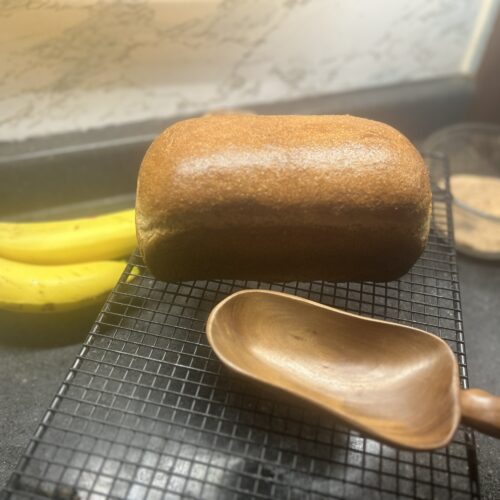
Super Soft Daily Bread Recipe
This is an enriched bread dough with low enough sugar content to be considered a daily bread.
Equipment
- 1 Kitchen In a Box Mixer or any stand mixer. You can even use your bread machine's dough cycle
- 1 gram scale I love this one! It's rechargeable, waterproof, and measures to the gram
- 1 pastry brush if you choose to do an egg wash
Ingredients
- 420 g wheat berries, hard white
- 225 g whole milk coconut milk or water can be used
- 1 whole egg I used one duck egg. You can also use 1 tbsp sunflower lecithin, and add a little extra water to compensate.
- 35 g extra virgin olive oil butter or oil of your choice would work well here
- 10 g date syrup leave it out, or use your choice of sweetener. This is just enough to give the yeast a boost.
- ⅛ tsp vitamin c powder You can use whole food based vitamin c powder such as camu camu, Pure Radiance C, or even 1 tbsp of fresh lemon juice or apple cider vinegar
- 60 g boiling water for yudane this is mixed with 30 grams of the flour from above as the first step after milling. It will turn into a paste, and that paste goes into the mixing bowl with the liquid from the recipe above
Ingredients Added After First Mix and Rest
- 8 g sea salt, celtic grey
- 11 g yeast (instant) If using active dry yeast, prove it first and add the proved mixture on the step for adding yeast.
Instructions
- Mill the flour.
- Mix 30 grams of the milled flour with 60 grams of boiling water, and carefully but quickly mix into a paste. Add to your mixing bowl.
- Add all other ingredients to the mixing bowl EXCEPT the salt and the yeast.
- Mix with the whisk (wire whips) for 1-3 minutes on high speed, or well combined.
- Let the mixture rest for at least 15 minutes up to an hour, covered.
- Add salt and yeast to the mixing bowl, and mix with the dough hook for another few minutes. Check for windowpane, or signs of it, by looking for a smooth, silky dough.
- Let the dough rise, covered, until doubled. This length of time will vary greatly depending up on your environment. If you have a proofing box, I'd estimate 30 minutes. When you press a finger into the dough to the first knuckle, it should remain depressed or slowly start filling back in.
- Preheat your oven to 350 F.
- Shape your dough into a loaf by forming a rectangle, folding it up, and then rolling it so the outside skin is nice and taut.
- Place into a greased or lined bread pan 8.5" x 4.5" , and let rise while your oven preheats.
- When the dough has risen, and the dough stays depressed or slowly fills back in when pressed with your finger, it's ready for baking.
- Optional: wash the top of the bread with egg wash (1 egg and 1 tbsp water, mixed) for a golden, shiny crust. For a more rustic looking crust, skip this step.
- Bake the bread until it's 190 F in the middle of the loaf. Top the pan with another pan that's upside down to get a crunchy crust, similar to using a dutch oven. For a softer crust, do not cover the bread with another pan.
- Use an instant read thermometer to tell when the bread is ready. I estimate about 30-45 minutes, depending upon your oven AND your environment. Remove from the oven once it's done.
- Let the bread cool, removed from it's pan, on a bread rack before slicing.
Video
Nutrition
Serving: 50gCalories: 119kcalCarbohydrates: 20gProtein: 4gFat: 3gSaturated Fat: 1gPolyunsaturated Fat: 0.2gMonounsaturated Fat: 2gCholesterol: 2mgSodium: 200mgPotassium: 32mgFiber: 4gSugar: 1gVitamin A: 23IUVitamin B1: 0.1mgVitamin B2: 0.05mgVitamin B3: 0.3mgVitamin B5: 0.2mgVitamin B6: 0.02mgVitamin B12: 0.1µgVitamin C: 0.02mgVitamin D: 0.2µgVitamin E: 0.3mgVitamin K: 1µgCalcium: 30mgIron: 1mg
Tried this recipe?Let us know how it was!